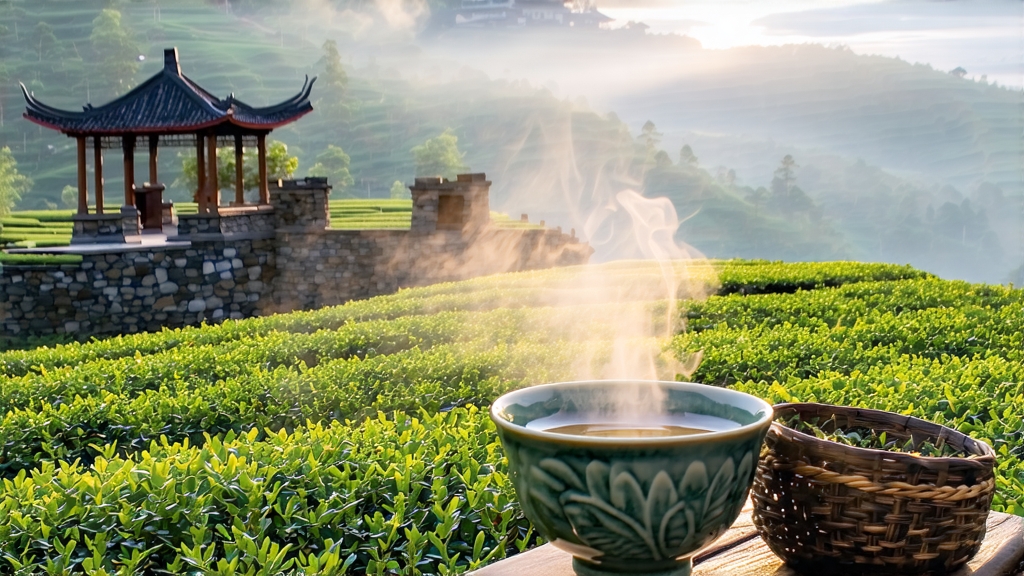
Tucked high on the mist-laced shoulders of Sichuan’s Meng Ding Mountain, where clouds brush the evergreen crowns at a thousand metres above the Chengdu plain, a tea once reserved for emperors still unfurls its velvet buds each early April. International drinkers may speak freely of Longjing or Da Hong Pao, yet few have tasted Meng Ding Huang Ya, the “Yellow Bud” whose name carries the colour of Chinese sovereignty and a flavour that slips like silk across the palate. This essay invites the curious abroad to discover the history, craft, and quiet ceremony of a tea that almost vanished, and to learn why its gentle golden liquor is now re-emerging as the most refined expression of China’s least-understood tea family: yellow tea.
1. A leaf fit for throne rooms
Meng Ding’s tea lore begins in the Western Han dynasty (206 BCE – 9 CE) when the Daoist monk Wu Lizhen planted seven tea bushes on the summit, declaring them “celestial herbs.” By the Tang dynasty (618-907) the mountain’s spring buds were riding a caravan of bamboo and silk south-east to Chang’an, paying tax in fragrance rather than coin. When Song emperor Huizong—himself a skilled tea connoisseur—established the “Tribute Tea Registry” in 1107, Meng Ding Huang Ya topped the list, wrapped in damask and sealed with wax bearing the imperial dragon. For eight centuries the tea travelled in such style, until the chaos of the late Qing and the rise of green-tea exports pushed yellow tea into obscurity. Only in 1959 did the Sichuan Tea Research Institute revive the original cultivar and re-stage the forgotten “sealed yellowing” technique, restoring a lost chapter of Chinese tea heritage.
2. One mountain, three micro-gardens
Today genuine Meng Ding Huang Ya comes exclusively from three frost-free hamlets—Ganlu, Wanchun, and Shangqing—arrayed along the eastern escarpment. Granite soils, 78 % relative humidity, and a 15 °C diurnal swing coax the local small-leaf Camellia sinensis var. sinensis to store amino acids while keeping tannins gentle. Gardens sit above the cloud base for two-thirds of the year, so buds mature slowly, growing 25 % smaller than those of nearby lowland bushes yet twice as thick in downy trichomes. The harvest window opens for barely ten mornings around Qingming (early April) when each bud still resembles a sparrow’s tongue—tight, blush-green, and tipped with pale gold.
3. The craft of “sealed yellowing”
Unlike green tea, which seeks to kill greenness outright, yellow tea walks a middle path: oxidation is neither encouraged (as in oolong) nor fully halted (as in green). After picking, the buds undergo six meticulous stages:
- Pan-firing (shaqing) – 4 min at 140 °C on pear-wood charcoal to rupture leaf enzymes.
- Initial rolling – 8 min under 6 kg pressure to bruise cell walls without breaking surface hairs.
- First wrap (menhuang, “sealed yellowing”) – Buds are piled 3 cm deep in linen squares, then buried in bamboo crates lined with wet straw. Temperature is held at 28 °C for 24 h; chlorophyll degrades into pheophytin, edges turn primrose.
- Low-temperature drying – 40 min at 80 °C to reduce moisture to 20 %.
- Second wrap – Another 18 h straw rest, during which non-enzymatic browning forms the tea’s hallmark ketones and lactones, yielding steamed-bean and orchid notes.
- Final desiccation – Slow charcoal bake at 60 °C until 5 % moisture, then hand-sorting to remove any stem darker than camel.
The entire cycle spans 72 h, twice the labour of everyday green tea, which explains why annual production rarely exceeds 1 200 kg.
4. Telling the real from the tinted
Because yellowing is time-consuming, some merchants merely tint green tea with a light roast and sell it as Huang Ya. Authentic Meng Ding displays four tell-tale signs:
- Dry leaf: straight, flat needles the colour of antique ivory with faint jade veins; when rubbed, the down should powder lightly onto the